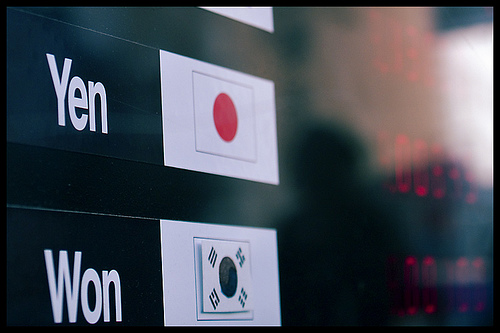If even the uber-fiscally conservative Germany could not meet the limits of 3 per cent of GDP fiscal deficit due to the high costs of funding the re-unification of Germany, why should the smaller states adhere to the Treaty?
The structural flaw of the Euro zone is that even though there may be a unified European Central Bank and a converging European financial supervisory system, there is no unified fiscal system. Thus, once a member country runs a large fiscal deficit, there is no central body to effectively coordinate fiscal policy.
Proponents of Asian monetary integration point to growth in trade integration as a pre-condition for future financial integration. Those who think that Asian integration is a pipe dream say that there is currently no political consensus, not even the makings of a unified monetary or currency policy, and little convergence on supervisory policy. Further, there are hardly any discussions within Asia on common fiscal policies.
The Euro problems are more warning signals to Asian reforms on what not to do and what to avoid, rather than positive indicators of the road to integration. But not all the lessons are negative. I can think of several ‘green shoots’ coming out of the Euro problems for Asia.
The first is that you can’t hurry the process. It takes time to get consensus on what is right for a large community of different interests and different cultures. If you ask ten Asian economists on what they think the future of Asian integration is, I am sure you will get more than ten opinions. Common thinking is non-existent, let alone common institutions. At least, European bureaucracies have been talking and bargaining with each other for more than 50 years through the centers’ of power in Brussels, Basel and Frankfurt.
Secondly, talk about Asian monetary integration has always been defensive rather than offensive, in the sense that some pooling of resources (such as an Asian Monetary Fund) could hopefully defend weaker Asian currencies from excessive speculation and instability. The reason why multilateralisation of the Chiang Mai initiatives took quite a long time to arrange is that immediately following the Asian financial crisis threats of instability receded, and thus there was little urgency to getting any agreement done. The problems of the Euro have given the Asian integration process more urgency.
Thirdly, in the last decade, differences in country income and wealth levels have become less unequal. With Japan in the doldrums and the rise of China, India, Gulf states and East Asia-ex Japan; Asian countries are now more evenly matched. Ten years ago, Japan was the sole advanced country, but today, China, India, Korea and Indonesia are members of the G20. Seven of the Asia Pacific’s financial centres are amongst the top 15 in the world according to the City of London Global Financial Centre Index.
Fourthly, the return of the RMB to a more flexible currency arrangement and the upward revaluation of the Asian currencies in recent months indicate that the financial markets are reflecting the shifting economic weight towards the East. Asia will be receiving more hot money flows and will have to cope with the same pressures that plagued East Asia in the early 1990s, just before the Asian financial crisis.
Fifth, the official attitude towards more controls over the speculative barbarians at the gate has changed, even as Germany unilaterally banned naked short selling and the IMF has acknowledged that capital controls are part of the macro-economic toolkits. The balance of power between markets and the central banks in managing currency stability has tilted back towards central banks.
None of the above positive signs add up to greater impetus for Asian monetary integration. Indeed, there is no sign that there is greater sense of regional cooperation, since Korea was also willing to put currency issues on the agenda of G20 in Toronto.
Much will depend on how China plays her cards in the near future. Shanghai has already been designated as the international financial centre for China and the RMB is becoming an important trade currency, particularly with neighbouring countries. The sheer weight of excess savings in the surplus countries will clearly give Asian financial centers’ more clout in the recycling of global funds. What is not obvious is how Asian policy-makers are institutionalising the process.
The process of Asian financial integration must depend first and foremost on the degree of deepening in Asian financial institutions. The process of creating diverse financial institutions has happened too slowly relative to the needs of the rising middle class and aging demographics. Asia has always prided itself on growth with relatively little financial repression, in the sense that depositors received only slightly negative real interest rates, with the benefits of repression given to the export and manufacturing sectors. In recent years, however, the rise of inflation has hurt the savers, but the benefits to the borrowers have been unevenly spread.
Perhaps the next phase of Asian financial integration will be less officially driven, and more market led through the removal of the barriers to Asian financial institutions integrating within the region. Allowing more Asian financial institutions into each others’ domestic markets is more of a concrete step towards regional integration than visionary statements.
Witness how Malaysia has allowed Chinese, Indian, Indonesia, Japanese and Middle East financial institutions into its home market. If this process accelerates and spreads, Asian financial integration will happen through the ramen bowl of inter-connected institutions. Note that I am not talking about spaghetti.
Andrew Sheng is Adjunct Professor at the University of Malaya and Tsinghua University, Beijing.


I agree with your sound recommendations.
The way forward for Asia-Pacific integration is to facilitate market-led integration.